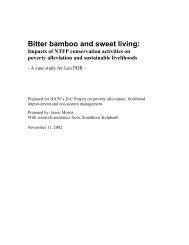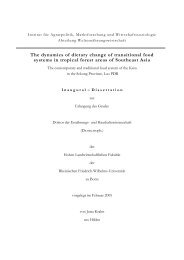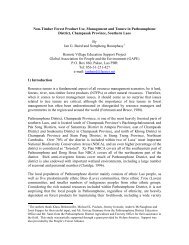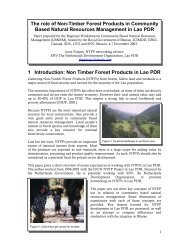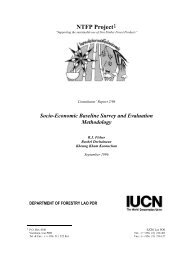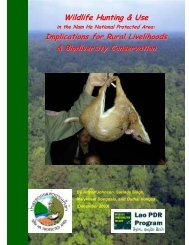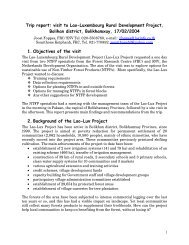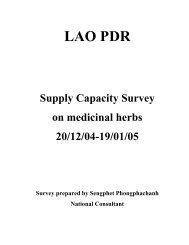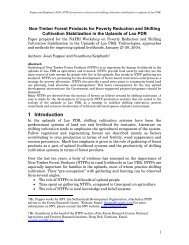You also want an ePaper? Increase the reach of your titles
YUMPU automatically turns print PDFs into web optimized ePapers that Google loves.
Table 6: Average family budgets, 5 villages, <strong>Nakai</strong> plateau, March 1997.<br />
Village 9eo;o7v[7q; Kh<strong>on</strong>ken Kaoy <strong>Nakai</strong> Sopphene Thalang AVERAGE %<br />
Total No Families 9eo;o7v[7q; 35 25 57 40 41<br />
NTFP's 1997 7 x f !__( n.a. 164,716 118,891 245,919 30,195 116,931 47%<br />
Livestock laf]Ph' n.a. 0 231,309 23,682 118,130 77,626 31%<br />
Off-farm ovd9kdg7njv'd}d n.a. 0 110,246 0 207,372 56,199 22%<br />
GROSS VALUE ]kpIa[ma's,qf n.a. 164,716 460,446 269,601 -232,398 250,755 100%<br />
Rice*** g0Qk n.a. -444,750 -284,202 -270,858 -25,027 -240,813 -96%<br />
NET VALUE n.a. -280,034 176,244 -1,257 -257,425 9,943 4%<br />
*) Amount of m<strong>on</strong>ey needed to buy rice (negative values) or surplus rice sold (positive values), based <strong>on</strong> a<br />
calculati<strong>on</strong> of surpluses after family c<strong>on</strong>sumpti<strong>on</strong>, calculated as 300 kg/head/year.<br />
4.2.2 Estimated quantities of NTFP’s collected<br />
A rough estimate of the total off-take of NTFP’s was calculated by multiplying average offtake<br />
per family by 850 , the total number of families <strong>on</strong> the plateau. What we have here is<br />
<strong>on</strong>ly a rough estimate, the actual off-take may be higher (see also table 12 in chapter 5). The<br />
results are shown in table 7. Harvesting of kisi resin has increased from 158 t<strong>on</strong>nes in 1996 to<br />
345 t<strong>on</strong>nes in 1997, over all 5 villages surveyed. B<strong>on</strong>g bark harvested has fallen back from<br />
211 t<strong>on</strong>nes in 1996 to 96 t<strong>on</strong>nes in 1997. This hints to depleti<strong>on</strong> of the stock. The situati<strong>on</strong> <strong>on</strong><br />
the rattan canes is less clear, harvesting seems to have come to a halt in the plateau area but is<br />
apparently still very much going <strong>on</strong> in the adjacent nati<strong>on</strong>al protected area (Dick Watling,<br />
IUCN, p.c.).<br />
Table 7:<br />
Estimated total extracti<strong>on</strong> of NTFP’s <strong>on</strong> the <strong>Nakai</strong> plateau.<br />
1996 1997<br />
b<strong>on</strong>g (kg) [q' d] 210,976 95,831<br />
kisi (kg) 0U-u d] 158,167 344,736<br />
cardamom(kg) s,kdcsoj' d] 3,771 1,122<br />
rattan canes(no) s;kpm6o glAo 10,268 0<br />
What are the most valuable NTFP’s collected for selling? Kisi resin is the most important<br />
product, going up from 28% of NTFP based family income in 1996 to 56% of average<br />
family income in 1997 (see table 8). Curiously rattan shoots have come up to sec<strong>on</strong>d place in<br />
1997, replacing b<strong>on</strong>g bark which has been greatly reduced. Rattan canes have all but<br />
disappeared, cardamom remains stable. This picture may still change as we are early in the<br />
year.



